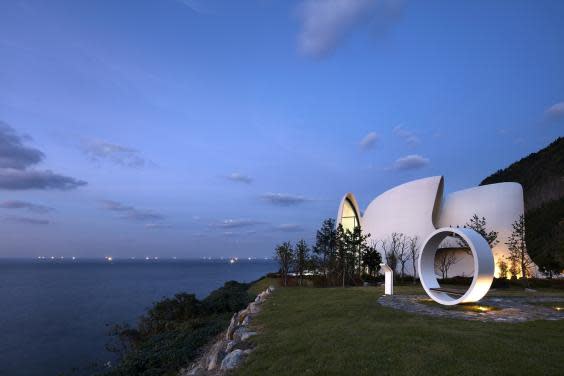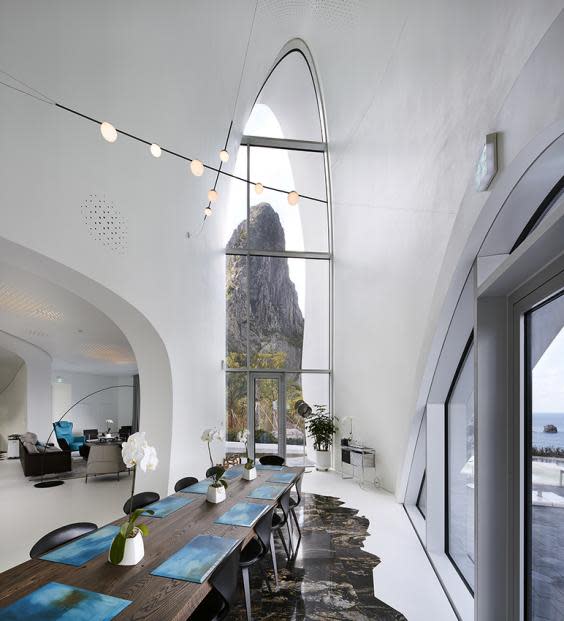Kosmos: The feng shui retreat on a South Korean island you’ve never heard of
After a flight to Seoul, a 2.5-hour train ride east to Pohang Port and 3.5-hour ferry journey across the East Sea, you’ll finally arrive in Ulleungdo. Flung off the eastern coast of South Korea, this 2.5-million-year-old volcanic island is considered one of the most beautiful destinations in Korea – and, yes, it’s well worth the journey.
On the remote island, travellers can trek through dense cedar-wood forests without seeing another person for miles, hike along craggy cliffs, scuba dive in pristine water and dine on local specialties such as freshly caught “flower” prawns or tender beef from native striped ox.
The island also lures those who’ve heard tales of its “sacred” atmosphere. When Choi Suk Soon, the CEO of Korean materials manufacturing company Kolon Glotech, first visited Ulleungdo six years ago, he stayed at a small guest house in Chusan-ri, on a cliff hugged by the East Sea and Songgot mountain, where sharp Seong Bong Peak (loosely translated to “emerging saint”) pierces the sky like an ice pick.
“Chusan-ri is known to have the strongest chi (energy) on the island due to Songgot mountain. It is where the energy of the mountain meets the energy of the sea,” says Choi. “Koreans believe that places with rich chi heal people’s energy and help their wishes come true.”
Enamoured with the island and its spiritual energy, the CEO bought the plot and built Kosmos Healing Stay. Opened last spring, the swirling white structure comprises two distinct sections: an eight-room boutique hotel dubbed Villa Terre, and exclusive four-room Villa Kosmos with a personal chef, outdoor deck, pool and two separate spas.
A futuristic white structure, the villa is designed to channel the fundamental Taoist principles of yin and yang – the philosophy that opposites are needed to maintain harmony – with its spiral shape, inspired by the yin-yang symbol. Meanwhile, the villa’s guest rooms aim to capture the spirit of the elements of the universe, including Mars (fire), Mercury (water), Jupiter (wood) and Venus (metal).

Upon arrival, a host assigns you one of the rooms based on your personal element, which they’ve calculated from your date of birth. If your base element is water, for example, you’ll stay in the blue-toned Mercury room. The idea being that if you are surrounded by your base element, you’ll feel more balanced and restored.

Each of the rooms features different materials and furniture to match the theme, including hand-picked designer chairs that double as valuable artwork. In Jupiter, you’ll find the award-winning wooden GJ Bow Chair by Danish designer Grete Jalk, while Mercury houses the world’s first curved glass chair, dubbed Ghost, by Italian architect and designer Cini Boeri.
Even the views have been carefully configured. “The room with a view of the sunrise was assigned the planet Mars, which in Taoism represents fire,” says Choi. “The room with view of the sea was assigned the planet Mercury, representing water.”
The astrological influence continues outdoors. In a grassy lawn overlooking the cliff, for example, there are two “Ring Chairs”. Framing the sunset behind Elephant Rock (so named for its shape) over the sea, the white ring has been positioned to boost yang energy, while the black ring is designed to enhance yin energy with views of the moon and Songgot mountain.
“We collected open-source data from the government’s astrology observatory to plot the trajectory of the sun and moon, and learned when and where the sun would rise, set and so on,” says Choi. “This allowed us to determine the orientation of the rings and optimise the viewing points.”
Even if you don’t believe in feng shui, chi, or astrology, the resort’s groundbreaking architecture completely sets it apart. Built by renowned Korean architect Chanjoong Kim of The System Lab, the whole project took roughly two and a half years to complete.

To perfect the building’s unconventional form, the architect experimented with countless moulds in a factory on the mainland, before moving all of the equipment and materials to the remote island.
“Getting the materials to Ulleungdo was a daunting task,” says Choi. “The lack of infrastructure and workers available made it a challenge to apply new construction techniques and ensure the quality of the construction itself. Even the weather proved to be an obstacle when arranging the logistics.”
It tends to be very windy and snowy on the island during winter.

The project was ambitious when it came to the construction method, too. To craft the curving, shell-like structure, Chanjoong used ultra-high performance concrete (UHPC). It’s so strong that the building doesn’t need steel reinforcements, but appears deceptively delicate. With this material, he could create a sinuous shape, origami-like folds, an airy vaulted atrium and perforated ceilings that stream in natural light.
“The System Lab poured the whole concrete structure on site at once, without using any steel, which has never been done before,” explains Choi. “If we were using another type of concrete, the thinnest walls would be 30cm. But with UPHC, the walls at Kosmos are just 12cm.”

That’s akin to the length of a typical pen. As a result, the end result looks light and airy – a sculptural complement to the mountain scenery.
“I wanted to create an existence that has its own distinct presence but does not conflict with the nature surrounding it, which has existed since ancient times,” adds Chanjoong. “I hope that visitors will be able to purely concentrate on resting by staying within such a harmonious structure.”
Travel essentials
Getting there
British Airways flies direct from London Heathrow to Seoul from £593 return.
Staying there
Kosmos offers doubles from 350,000 won (£240), B&B.

